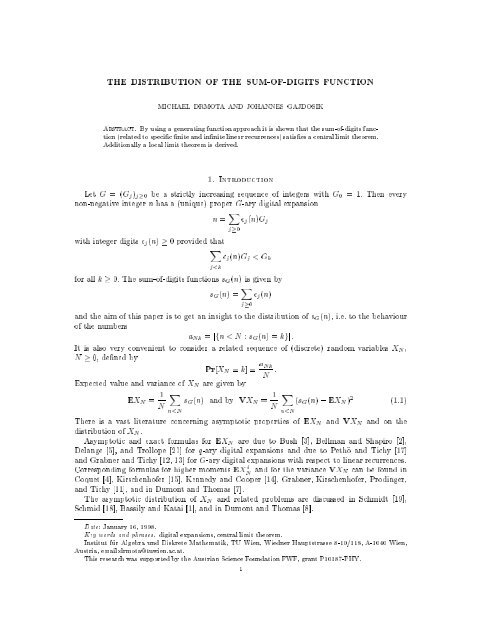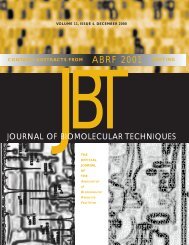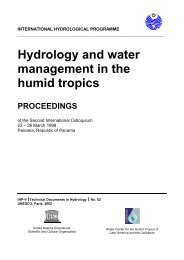X X X X X - Science Reference
X X X X X - Science Reference
X X X X X - Science Reference
You also want an ePaper? Increase the reach of your titles
YUMPU automatically turns print PDFs into web optimized ePapers that Google loves.
tion(relatedtospecicniteandinnitelinearrecurrences)satisesacentrallimittheorem. Additionallyalocallimittheoremisderived. Abstract.Byusingageneratingfunctionapproachitisshownthatthesum-of-digitsfunc- THEDISTRIBUTIONOFTHESUM-OF-DIGITSFUNCTION MICHAELDRMOTAANDJOHANNESGAJDOSIK<br />
non-negativeintegernhasa(unique)properG-arydigitalexpansion withintegerdigitsj(n)0providedthat LetG=(Gj)j0beastrictlyincreasingsequenceofintegerswithG0=1.Thenevery 1.Introduction<br />
forallk0.Thesum-of-digitsfunctionssG(n)isgivenby sG(n)=Xj0j(n) Xj
approachwasusedin[6].) bytheuseofgeneratingfunctions,whereitisalsopossibletoderivealocallimitlaw.(Asimilar 2Themainpurposeofthispaperistoproveasymptoticnormality(ofthedistributionofXN) MICHAELDRMOTAANDJOHANNESGAJDOSIK<br />
2.1.FiniteRecurrences.Intherstcasewewillmakethefollowingassumptions: niteorinnitelinearrecurrences. 1.Thereexistnon-negativeintegersai,1ir,suchthat(forjr) InthepresentpaperwewilldealwithbasissequencesG=(Gj)j0whichsatisfyspecic Gj=rXi=1aiGj?i: 2.Results<br />
Insection3wewillshowthattheaboveassumptionsimplythatthecharactericticpolynomial 2.gcdfi1:ai6=0g=1. 3.Forallj>rand1k
facts(see[5,17,13,15,7,10]).Moreprecisely,muchmoreisknownaboutthefollowingO(1)terms.Thereforewewillnotpresentaproof.anceofXN(dened)in(1.1).Actuallythisstatementismoreorlessacollectionofwellknown2.3.AsymptoticProperties.Firstwestateatheoremconcerningexpectedvalueandvari- andsoweareinsimilarsituationasabove. THEDISTRIBUTIONOFTHESUM-OF-DIGITSFUNCTION 3<br />
abovetypes.Set Theorem2.1.SupposethatG=(Gj)j0satisesaniteorinnitelinearrecurrenceofthe forzinasucientlysmall(complex)neighbourhoodofz0=1suchthat(1)=.Then andlet1=(z)denotethe(analytic)solutionu=1=(z)oftheequation EXN=1NXn
wehaverPj=1aj=G(1)>1andconsequentlyu01ofmaximalmodulus.Set 4u!1G(u)=1thereuniquelyexistsu0>0withG(u0)=1.SinceGnisstrictlyincreasing MICHAELDRMOTAANDJOHANNESGAJDOSIK<br />
Furthermore,ifjuj=u0butu6=u0thenthegcd-conditiongcdfi1:ai6=0g=1impliesthat Thus,=1=u0>1isasimplerootofP(u). Consequently,therearenorootsofP(u)otherthanwithmodulus. Ifjuj
impliesj?i(n)=kandconsequentlyl(n)=l(m)for0l
wherebj;k=aGjk=jfnj1>>jL?1andej>0.Then Xk0aNkzk=L?1 N=L?1 Xl=0bjl(z)zPl?1 Xl=0elGjl Proof.ByLemma3.2(whichisalsovalidinthecaseofinniterecurrences)wehave aNk=L?1 h=0ehel?1 Xi=0zi: =L?1 Xl=0el?1<br />
Xi=0bjl;k?Pl?1 Xi=0(m
THEDISTRIBUTIONOFTHESUM-OF-DIGITSFUNCTION 7<br />
Proof.Firstly,letGnsatisfyanitelinearrecurrenceoftheabovetype.Then1?G(1;u)=<br />
urP(u?1),whereP(u)isthecharacteristicpolynomial.ThusG(1;?1)=0.Furthermore,since<br />
@<br />
@uG(z;u)
inanopenneighbourhoodoft=0inR.NowsupposethatN=L?1 jL?1andel>0istheG-aryexpansionofN.ThenbyLemma3.6andthetrivialestimate 8el?1 Ps=0eits=el(1+O(t))wehave Xk0aNkeikt=L?1 Xl=0bjl(eit)eitPl?1 MICHAELDRMOTAANDJOHANNESGAJDOSIK<br />
h=0ehel?1 Xs=0eits Pl=0elGjlwithj0>j1>><br />
andthat Nowobservethat=L?1 Xl=0elGjleijlt?jl2t2=2+itPl?1<br />
HenceEeit(XN?N)=N=e?itN=N1NXk0aNkeikt=N e?itN=N=e?it(=)j1=2 itN=it j1=2 0?1+O(j?1 h=0eheO(t+jlt3+(1?)jl)+O(N(1?)): 0(1+O(j?1 0);<br />
=e?t2=2L?1 Xl=0elGjl Neit=(j1=2 0)?Pl?1 h=0eh?(j0?jl)?t2(jl?j0)=(2j0) 0)):<br />
Let">0bea(small)realnumberandletbedenedbyj?1>j0?j"0j.Then j0?j
forjtj(logN)?2thatZT Hence,(2.2)follows. THEDISTRIBUTIONOFTHESUM-OF-DIGITSFUNCTION ?TN(t) tdt=O(logN)?1=2+"(loglogN): 5.LocalLimitLaw 9<br />
preciseinformationonthebehaviourofbj(z). Proposition5.1.SupposethatG=(Gj)j0satisesaniteorinniterecurrenceofthe abovetypes.Thenthereexist>0and>0suchthat uniformlyforjtj,whereC(z)and(z)areasinProposition4.1,and InordertoprovealocallimitlawforXN,i.e.thesecondpartorTheorem2.2,weneedmore bj(eit)=C(eit)(eit)j+O(1?)j bj(eit)=O(1?)j (5.1)<br />
analytic(andthereforebounded)inthisrangeandweobtain uniformlyforjtj. Proof.Obviously,(5.1)followsfrom(4.1)forsome>0. andjuj1=.Hence,bycontinuitythereexist">0and>0suchthatj1?G(u;eit)j uniformlyfor(real)twithjtjand(complex)uwithjuj1+".Thus,B(eit;u)is Fortheproofof(5.2)wejusthavetoobservethatjG(z;u)j0. pointapproximations. bj(eit)=1<br />
Proposition5.2.Wehave WithhelpofProposition5.1itispossibletoderiveasymptoticexpansionsforbj;kviasaddle =O(1?)j; 2iZ juj=1=+"B(eit;u)du uj+1<br />
Since Proof.WeagainuseCauchy'sformula uniformlyforallj;k0. bj;k=Gj Zjtjjbj(eit)jdt=O(1?)j=O(Gj=j)<br />
p2j2exp?(k?j)2 bj;k=1 2Z?bj(eit)e?iktdt: 2j2+O(j?1=2)<br />
where0
Finally,I1=1 10 =1 2Zjtjj?"Cjeit(j?k)?j2t2=2?1+O(jjt3j+jtj)dt+O(1?)j 2Z1 ?1Cjeit(j?k)?j2t2=2dt+O MICHAELDRMOTAANDJOHANNESGAJDOSIK<br />
=Cj +O p2j2exp?(k?j)2 Zjtjj?"Cje?j2t2=2(jjt3j+jtj)dt!+O(1?)j 2j2+O(j=j) Zjtj>j?"Cje?j2t2=2dt!<br />
=Gj p2j2exp?(k?j)2<br />
Proof.AsintheproofofProposition4.2wesupposethatN=L?1 ThiscompletestheproofofProposition5.2. FinallyProposition5.2andLemma3.6canbeusedtocompletetheproofofTheorem2.2. 2j2+O(Gj=j):<br />
andletbedenedbyj?1>j0?j"0j.Thenby(3.5) jL?1andel>0)istheG-aryexpansionofN.Furthermore,let">0bea(small)realnumber aNk=L?1 Xl=0el?1 Xi=0bjl;k?Pl?1 h=0eh?i Pl=0elGjl(withj0>j1>><br />
Ifl
THEDISTRIBUTIONOFTHESUM-OF-DIGITSFUNCTION 11<br />
weobtain<br />
aNk=N<br />
p22Nexp?(k?N)2<br />
22Nk?1<br />
Xl=0elGjl<br />
N1+Oj"?1=2<br />
0logj0+O(Gj0=j0)<br />
=N<br />
p22Nexp?(k?N)2<br />
22N+Oj"?1=2<br />
0logj0:<br />
Ifjk?Njj1=2<br />
0logj0thenwehaveforl<<br />
bjl;k?Pl?1<br />
h=0eh?i=Ojlj?1=2<br />
0exp?(logj0)2<br />
42<br />
=O?jlj?1<br />
0<br />
whichnallygives aNk=O(?j0j?1<br />
0+O L?1<br />
Xl=Gjl<br />
j1=2<br />
l!<br />
=O(Gj0=j0):<br />
ThiscompletestheproofofTheorem2.2.<strong>Reference</strong>s<br />
[1]N.L.BassilyandI.Katai,Distributionofthevaluesofq-additivefunctionsonpolynomialsequences,<br />
ActaMath.Hung.68(1995),353{361.<br />
[2]R.BellmanandH.N.Shapiro,Onaprobleminadditivenumbertheory,Ann.Math.49(1948),333{340.<br />
[3]L.E.Bush,Anasymptoticformulafortheaveragesumofthedigitsofintegers,Am.Math.Monthly47<br />
(1940),154{156.<br />
[4]J.Coquet,Powersumsofdigitalsums,J.NumberTh.22(1986),161{176.<br />
[5]H.DelangeSurlafonctionsommatoiredelafonction"SommedeChires",L'Enseignementmath.21<br />
(1975),31{77.<br />
[6]M.DrmotaandM.Ska lba,TheparityoftheZeckendorfsum-of-digits-function,preprint.<br />
[7]J.M.DumontandA.Thomas,Digitalsummomentsandsubstitutions,ActaArith.64(1993),205{225.<br />
[8]J.M.DumontandA.Thomas,Gaussianasymptoticpropertiesofthesum-of-digitsfunctions,J.Number<br />
Th.62(1997),19{38.<br />
[9]C.-G.Esseen,Fourieranalysisofdistributionfunctions.AmathematicalstudyoftheLaplace-Gaussian<br />
law,ActaMath.77(1945),1{125.<br />
[10]J.Gajdosik,KombinatorischeFaktorisierungenundZiernentwicklungen,thesis,TUWien,1996.<br />
[11]P.J.Grabner,P.Kirschenhofer,H.Prodinger,andR.F.Tichy,Onthemomentsofthesum-of-digits<br />
function,in:ApplicationsofFibonacciNumbers5(1993),263{271<br />
[12]P.J.GrabnerandR.F.Tichy,Contributionstodigitexpansionswithrespecttolinearrecurrences,J.<br />
NumberTh.36(1990),160{169.<br />
[13]P.GrabnerandR.F.Tichy,-Expansions,linearrecurrences,andthesum-of-digitsfunction,<br />
manuscriptamath.70(1991),311{324.<br />
[14]R.E.KennedyandC.N.Cooper,AnextensionofatheorembyCheoandYienconcerningdigitalsums,<br />
FibonacciQ.29(1991),145{149.<br />
[15]P.Kirschenhofer,Onthevarianceofthesumofdigitsfunction,LectureNotesMath.1452(1990),<br />
112{116.<br />
[16]W.Parry,Onthe-expansionofrealnumbers,ActaMath.Acad.Sci.Hung.,12(1961),401{416.<br />
[17]A.PethoandR.F.Tichy,Ondigitexpansionswithrespecttolinearrecurrences,J.NumberTh.33<br />
(1989),243{256.<br />
[18]J.Schmid,Thejointdistributionofthebinarydigitsofintegermultiples,ActaArith.43(1984),391{415.<br />
[19]W.M.Schmidt,Thejointdistributionthedigitsofcertainintegers-tuples,Studiesinpuremathematics,<br />
Mem.ofP.Turan(1983),605{622.<br />
[20]H.Trollope,Anexplicitexpressionforbinarydigitalsums,Meth.Mag.41(1968),21{25.















